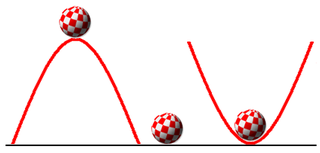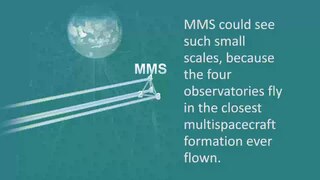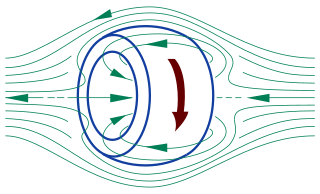Related Research Articles

The stability of a plasma is an important consideration in the study of plasma physics. When a system containing a plasma is at equilibrium, it is possible for certain parts of the plasma to be disturbed by small perturbative forces acting on it. The stability of the system determines if the perturbations will grow, oscillate, or be damped out.
A plasma afterglow is the radiation emitted from a plasma after the source of ionization is removed. The external electromagnetic fields that sustained the plasma glow are absent or insufficient to maintain the discharge in the afterglow. A plasma afterglow can either be a temporal, due to an interrupted (pulsed) plasma source, or spatial, due to a distant plasma source. In the afterglow, plasma-generated species de-excite and participate in secondary chemical reactions that tend to form stable species. Depending on the gas composition, super-elastic collisions may continue to sustain the plasma in the afterglow for a while by releasing the energy stored in rovibronic degrees of freedom of the atoms and molecules of the plasma. Especially in molecular gases, the plasma chemistry in the afterglow is significantly different from the plasma glow. The afterglow of a plasma is still a plasma and as thus retains most of the properties of a plasma.
The Hessdalen lights are unexplained lights observed in a 12-kilometre-long (7.5 mi) stretch of the Hessdalen valley in rural central Norway.

In plasma physics, an Alfvén wave, named after Hannes Alfvén, is a type of magnetohydrodynamic wave in which ions oscillate in response to a restoring force provided by an effective tension on the magnetic field lines.

A field-reversed configuration (FRC) is a type of plasma device studied as a means of producing nuclear fusion. It confines a plasma on closed magnetic field lines without a central penetration. In an FRC, the plasma has the form of a self-stable torus, similar to a smoke ring.

The Large Plasma Device is an experimental physics device housed at the Basic Plasma Science Facility at UCLA. It is designed as a general purpose laboratory for experimental plasma physics research. The device began operation in 1991 and was upgraded in 2001 to its current version. The modern LAPD is operated as a national user facility, in which half the research time on the device is open to scientists at other institutions and facilities.
Plasma acceleration is a technique for accelerating charged particles, such as electrons, positrons, and ions, using the electric field associated with electron plasma wave or other high-gradient plasma structures. The plasma acceleration structures are created either using ultra-short laser pulses or energetic particle beams that are matched to the plasma parameters. These techniques offer a way to build high performance particle accelerators of much smaller size than conventional devices. The basic concepts of plasma acceleration and its possibilities were originally conceived by Toshiki Tajima and Prof. John M. Dawson of UCLA in 1979. The initial experimental designs for a "wakefield" accelerator were conceived at UCLA by Prof. Chan Joshi et al. Current experimental devices show accelerating gradients several orders of magnitude better than current particle accelerators over very short distances, and about one order of magnitude better at the one meter scale.
A dense plasma focus (DPF) is a type of plasma generating system originally developed as a fusion power device starting in the early 1960s. The system demonstrated scaling laws that suggested it would not be useful in the commercial power role, and since the 1980s it has been used primarily as a fusion teaching system, and as a source of neutrons and X-rays.
A dusty plasma is a plasma containing millimeter (10−3) to nanometer (10−9) sized particles suspended in it. Dust particles are charged and the plasma and particles behave as a plasma. Dust particles may form larger particles resulting in "grain plasmas". Due to the additional complexity of studying plasmas with charged dust particles, dusty plasmas are also known as complex plasmas.
A helicon is a low frequency electromagnetic wave that can exist in bounded plasmas in the presence of a magnetic field. The first helicons observed were atmospheric whistlers, but they also exist in solid conductors or any other electromagnetic plasma. The electric field in the waves is dominated by the Hall effect, and is nearly at right angles to the electric current ; so that the propagating component of the waves is corkscrew-shaped (helical) - hence the term “helicon,” coined by Aigrain.
High-power impulse magnetron sputtering is a method for physical vapor deposition of thin films which is based on magnetron sputter deposition. HIPIMS utilises extremely high power densities of the order of kW⋅cm−2 in short pulses (impulses) of tens of microseconds at low duty cycle of < 10%. Distinguishing features of HIPIMS are a high degree of ionisation of the sputtered metal and a high rate of molecular gas dissociation which result in high density of deposited films. The ionization and dissociation degree increase according to the peak cathode power. The limit is determined by the transition of the discharge from glow to arc phase. The peak power and the duty cycle are selected so as to maintain an average cathode power similar to conventional sputtering (1–10 W⋅cm−2).
A double layer is a structure in a plasma consisting of two parallel layers of opposite electrical charge. The sheets of charge, which are not necessarily planar, produce localised excursions of electric potential, resulting in a relatively strong electric field between the layers and weaker but more extensive compensating fields outside, which restore the global potential. Ions and electrons within the double layer are accelerated, decelerated, or deflected by the electric field, depending on their direction of motion.
An ionization instability is any one of a category of plasma instabilities which is mediated by electron-impact ionization. In the most general sense, an ionization instability occurs from a feedback effect, when electrons produced by ionization go on to produce still more electrons through ionization in a self-reinforcing way.

Plasma is one of the four fundamental states of matter, and was first described by chemist Irving Langmuir in the 1920s. It consists of a gas of ions – atoms which have some of their orbital electrons removed – and free electrons. Plasma can be artificially generated by heating a neutral gas or subjecting it to a strong electromagnetic field to the point where an ionized gaseous substance becomes increasingly electrically conductive. The resulting charged ions and electrons become influenced by long-range electromagnetic fields, making the plasma dynamics more sensitive to these fields than a neutral gas.

The PK-3 Plus or laboratory was a joint Russian-German laboratory for the investigation of dusty/complex plasmas on board the International Space Station (ISS), with the principal investigators at the German Max Planck Institute for Extraterrestrial Physics and the Russian Institute for High Energy Densities. It was the successor to the PKE Nefedov experiment with improvements in hardware, diagnostics and software. The laboratory was launched in December 2005 and was operated for the first time in January 2006. It was used in 21 missions until it was deorbited in 2013. It is succeeded by the PK-4 Laboratory.

The Tanpopo mission is an orbital astrobiology experiment investigating the potential interplanetary transfer of life, organic compounds, and possible terrestrial particles in the low Earth orbit. The purpose is to assess the panspermia hypothesis and the possibility of natural interplanetary transport of microbial life as well as prebiotic organic compounds.

The MARHy Hypersonic low density Wind Tunnel, located at the ICARE Laboratory in Orléans, France, is a research facility used extensively for fundamental and applied research of fluid dynamic phenomena in rarefied compressible flows. Its name is an acronym for Mach Adaptable Rarefied Hypersonic and the wind tunnel is recorded under this name under the European portal MERIL.
Nathaniel Joseph Fisch is an American plasma physicist known for pioneering the excitation of electrical currents in plasmas using electromagnetic waves, which was then used in tokamak experiments. This contributed to an increased understanding of plasma wave-particle interactions in the field for which he was awarded the James Clerk Maxwell Prize for Plasma Physics in 2005 and the Hannes Alfvén Prize in 2015.
Noah Hershkowitz is an American experimental plasma physicist. He was jointly awarded the 2004 James Clerk Maxwell Prize for Plasma Physics with Valery Godyak for his research on low-temperature plasmas. These include radio frequency wave heating, sheath physics, potential profiles, diagnostic probes, and the industrial applications of plasmas.
Gregor Eugen Morfill is a German physicist who works in basic astrophysical research and deals with complex plasmas and plasma medicine.
References
- 1 2 Pustylnik, M. Y. (2016). "Plasmakristall-4: New complex (dusty) plasma laboratory on board the International Space Station". Review of Scientific Instruments. 87 (9): 093505. Bibcode:2016RScI...87i3505P. doi:10.1063/1.4962696. PMID 27782568.
- ↑ Schwabe, M. (2019). "Image Registration with Particles, Examplified with the Complex Plasma Laboratory PK-4 on Board the International Space Station". Journal of Imaging. 5 (3): 39. doi: 10.3390/jimaging5030039 .
- ↑ Jaiswal, S. (2018). "Dust density waves in a dc flowing complex plasma with discharge polarity reversal". Physics of Plasmas. 25 (8): 083705. arXiv: 1805.07284 . Bibcode:2018PhPl...25h3705J. doi:10.1063/1.5040417.
- ↑ Yaroshenko, V. (2019). "Excitation of low-frequency dust density waves in flowing complex plasmas". Physics of Plasmas. 26 (5): 053702. Bibcode:2019PhPl...26e3702Y. doi:10.1063/1.5097128.
- ↑ Usachev, A. D. (2018). "Influence of dust particles on the neon spectral line intensities at the uniform positive column of dc discharge at the space apparatus "Plasma Kristall-4"". Journal of Physics: Conference Series. 946 (1): 012143. Bibcode:2018JPhCS.946a2143U. doi: 10.1088/1742-6596/946/1/012143 .
- ↑ Dietz, C. (2017). "Recent microgravity experiments with complex direct current plasmas". Contributions to Plasma Physics. 58: 21–29. doi:10.1002/ctpp.201700055.